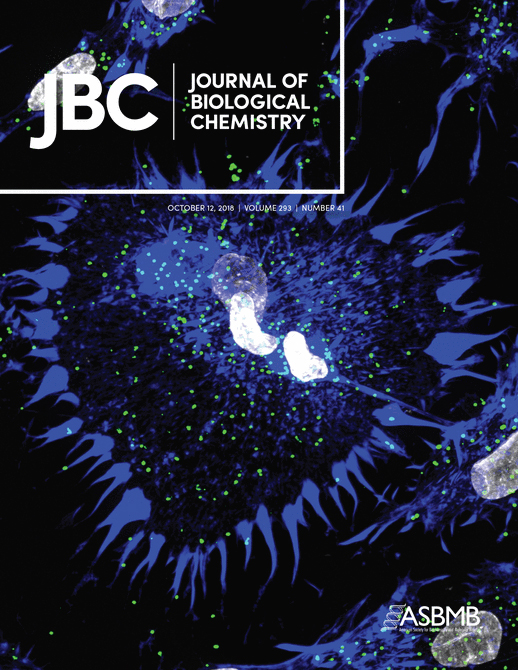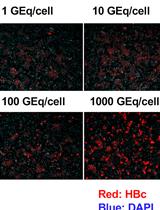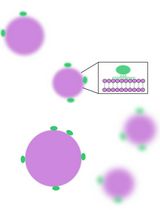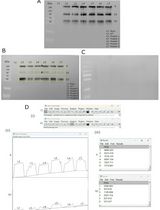- EN - English
- CN - 中文
Identification of Buffer Conditions for Optimal Thermostability and Solubility of Herpesviral Protein UL37 Using the Thermofluor Assay
用热荧光法鉴定疱疹病毒蛋白UL37的最佳热稳定性和溶解度的缓冲液条件
发布: 2020年06月20日第10卷第12期 DOI: 10.21769/BioProtoc.3662 浏览次数: 3810
评审: Anca Flavia SavulescuCristina SuárezVikas Duhan
Abstract
Structural and biochemical studies of proteins require high amounts of stable, purified proteins. Protein stability often depends on the buffer composition, which includes pH and concentration of salts or other solutes such as glycerol, hence an efficient method for identifying optimal buffer conditions for stability would minimize time and resources used for protein purification and further studies. This protocol describes the use of the Thermofluor assay, in combination with a custom 24-condition screen, to identify buffer conditions that increase protein thermostability, using the conserved herpesviral protein UL37 as an example. Detailed instructions on screen conditions, running the Thermofluor MATLAB script, and analyzing the data are provided. In comparison to circular dichroism (CD), the buffer screen in combination with Thermofluor assay provides a faster and more informative method to analyze protein thermostability.
Keywords: Thermofluor (热氟)Background
Conserved across herpesviruses, the protein UL37 has multiple functions in the viral lifecycle and is required for efficient viral replication. As a component of viral tegument–a layer sandwiched between the genome-containing capsid and the lipid envelope–UL37 is not only necessary for viral assembly (Desai et al., 2001; Jambunathan et al., 2014), but is also required for efficient capsid trafficking (Leege et al., 2009), neuroinvasion (Richards et al., 2017), and counteraction of the host innate immune response (Liu et al., 2008; Zhao et al., 2016). A better understanding of the nature of its multifunctionality requires detailed knowledge of its structure and biochemical properties, which, in turn requires well-behaved purified protein.
Initial preparations of different UL37 constructs varied in solubility, monodispersity, and yield of purified protein, making protein preparations inconsistent and further characterizations irreproducible. Since buffer optimization is a straightforward approach to addressing these concerns, we developed a 24-condition screen that varies buffering agents, pH, and concentrations of NaCl and glycerol and used it in combination with a Thermofluor assay (Phillips et al., 2011) to identify buffer conditions that maximize thermostability. The N-terminal and C-terminal halves of UL37 had variable average thermal stabilities and optimal buffer conditions (Figure 1, Table 1). Yet in all cases, conditions that increased protein stability also improved protein solubility, ultimately increasing the yields of purified protein, which facilitated downstream biochemical characterization.
The Thermofluor assay has many advantages over circular dichroism (CD), which is also used to monitor protein stability (Greenfield, 2006). First, the CD can only test one condition at a time whereas the Thermofluor assay is high throughout, screening up to 384 conditions simultaneously. Second, CD only estimates the secondary structure, whereas the Thermofluor assay provides an assessment of the tertiary structure. Third, CD signal is sensitive to changes in buffer components whereas essentially any buffer can be used in the Thermofluor assay. The buffer screen described here is a good starting point for characterizing a protein of unknown biochemical properties (stability, solubility) but can be customized or expanded for individual proteins based on available biochemical information. Finally, the Thermofluor assay can also be used to assess the domain organization of larger proteins by determining whether multiple domains of a large protein represent independently folded units, thereby increasing understanding of protein structure and function.
Materials and Reagents
- 1.7 ml microcentrifuge tubes (Thomas Scientific, catalog number: 1159M35 )
- 96-well PCR microplate (Thermo Scientific, catalog number: AB0800 )
- TBS (Tris-buffered saline) (150 mM NaCl, 20 mM Tris pH 7.5)
- SYPRO Orange Protein Gel Stain (Thermo Fisher Scientific, catalog number: S6650 )
- Transparent microplate sealing film (Hampton Research, ClearSeal, catalog number: HR4-521 )
- Sodium Acetate (Fisher Scientific, catalog number: BP334 )
- Sodium Citrate (Fisher Scientific, catalog number: S279 )
- MES (Sigma-Aldrich, catalog number: M2933 )
- Sodium Cacodylate (Sigma-Aldrich, catalog number: C4945 )
- Bis-Tris (Fisher Scientific, catalog number: BP301 )
- Imidazole (Fisher Scientific, catalog number: AC301872500 )
- MOPS (American Bioanalytical, catalog number: AB01270 )
- HEPES (Fisher Scientific, catalog number: BP310500 )
- Tris (Fisher Scientific, catalog number: BP152 )
- Bicine (Sigma-Aldrich, catalog number: B3876 )
- Glycine (Fisher Scientific, catalog number: BP381 )
- CHES (Sigma-Aldrich, catalog number: C2885 )
- Ethanolamine (ACROS organics, catalog number: AC149582500 )
- CAPS (Sigma-Aldrich, catalog number: C2632 )
- Glycerol (Chem-Impex, catalog number: 30144 )
- Sodium Chloride (Fisher Scientific, catalog number: S271 )
- 45 µg protein of interest (for 24 conditions).
Notes:- Protein should be homogenous (single band on an SDS-PAGE gel) and monodisperse (a single peak on size-exclusion chromatography).
- Proteins used for this protocol included the N and C terminal domains of UL37 homolog from pseudorabies virus (PRV UL37N, PRV UL37C) and the full-length protein (PRV UL37FL). All proteins used here were purified using two rounds of affinity chromatography and one round of size-exclusion chromatography. Detailed instructions on purification of PRV UL37 can be found in Pitts et al. (2014) and Koenigsberg et al. (2018). Multiple protein batches resulted in comparable thermostability profiles for each protein.
Equipment
- Benchtop centrifuge (Beckman Coulter, model: Allegra X-15R )
- qPCR machine (Roche, LightCycler 480, catalog number: 0 5015278001 )
Software
- ThermoQ (MATLAB, MathWorks, http://www.hotproteins.com)
Procedure
文章信息
版权信息
© 2020 The Authors; exclusive licensee Bio-protocol LLC.
如何引用
Readers should cite both the Bio-protocol article and the original research article where this protocol was used:
- Koenigsberg, A. L., Pitts, J. D. and Heldwein, E. E. (2020). Identification of Buffer Conditions for Optimal Thermostability and Solubility of Herpesviral Protein UL37 Using the Thermofluor Assay. Bio-protocol 10(12): e3662. DOI: 10.21769/BioProtoc.3662.
- Koenigsberg, A. L. and Heldwein, E. E. (2018). The dynamic nature of the conserved tegument protein UL37 of herpesviruses. J Biol Chem 293(41): 15827-15839.
分类
微生物学 > 微生物生物化学 > 蛋白质
生物化学 > 蛋白质 > 荧光
您对这篇实验方法有问题吗?
在此处发布您的问题,我们将邀请本文作者来回答。同时,我们会将您的问题发布到Bio-protocol Exchange,以便寻求社区成员的帮助。
Share
Bluesky
X
Copy link














